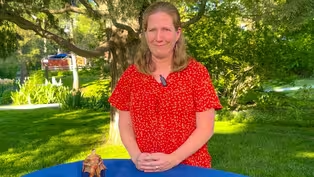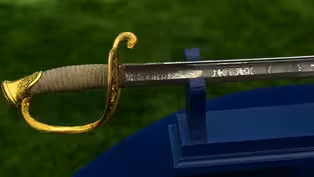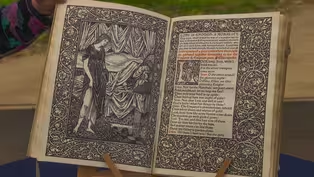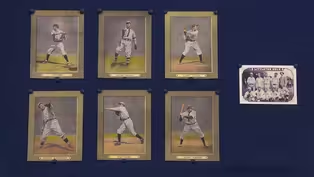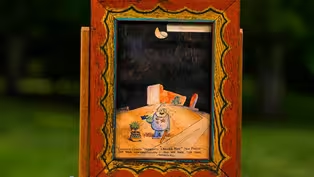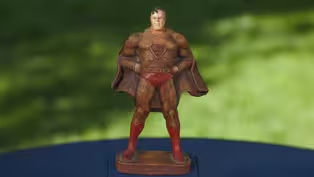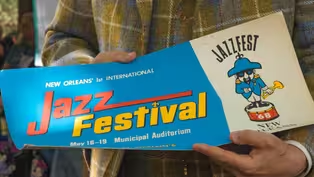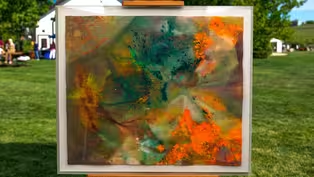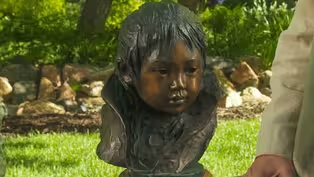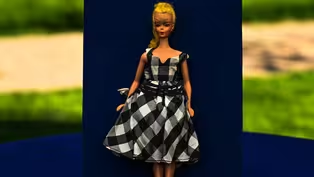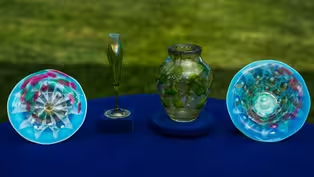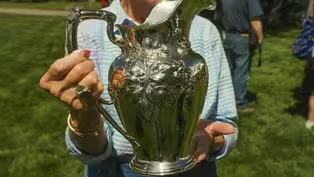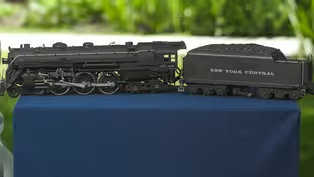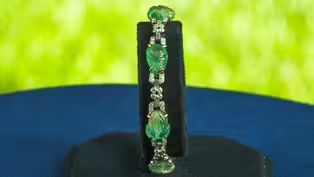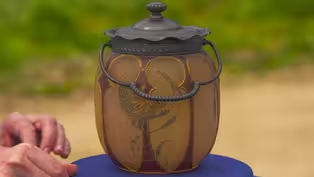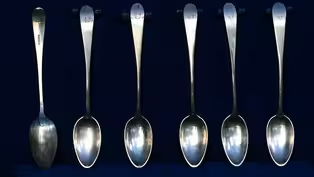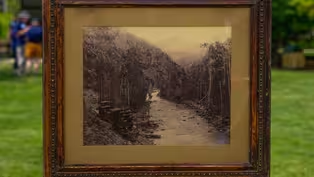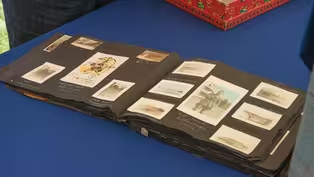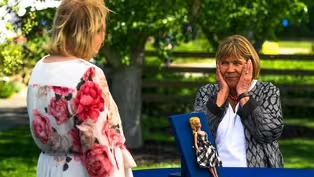
Denver Botanic Gardens Chatfield Farms, Hour 2
Season 29 Episode 11 | 52m 26sVideo has Closed Captions
ROADSHOW strikes gold in Colorado with amazing finds from a stop in Littleton!
ROADSHOW strikes gold in Colorado with amazing finds including Paul Revere Jr. silver tablespoons, a 1942 DC Comics promotional Superman figurine and a 1974 Sam Gilliam June 5 acrylic painting. One is $125,000 to $150,000!
Problems playing video? | Closed Captioning Feedback
Problems playing video? | Closed Captioning Feedback
Funding for ANTIQUES ROADSHOW is provided by Ancestry and American Cruise Lines. Additional funding is provided by public television viewers.

Denver Botanic Gardens Chatfield Farms, Hour 2
Season 29 Episode 11 | 52m 26sVideo has Closed Captions
ROADSHOW strikes gold in Colorado with amazing finds including Paul Revere Jr. silver tablespoons, a 1942 DC Comics promotional Superman figurine and a 1974 Sam Gilliam June 5 acrylic painting. One is $125,000 to $150,000!
Problems playing video? | Closed Captioning Feedback
How to Watch Antiques Roadshow
Antiques Roadshow is available to stream on pbs.org and the free PBS App, available on iPhone, Apple TV, Android TV, Android smartphones, Amazon Fire TV, Amazon Fire Tablet, Roku, Samsung Smart TV, and Vizio.
Buy Now
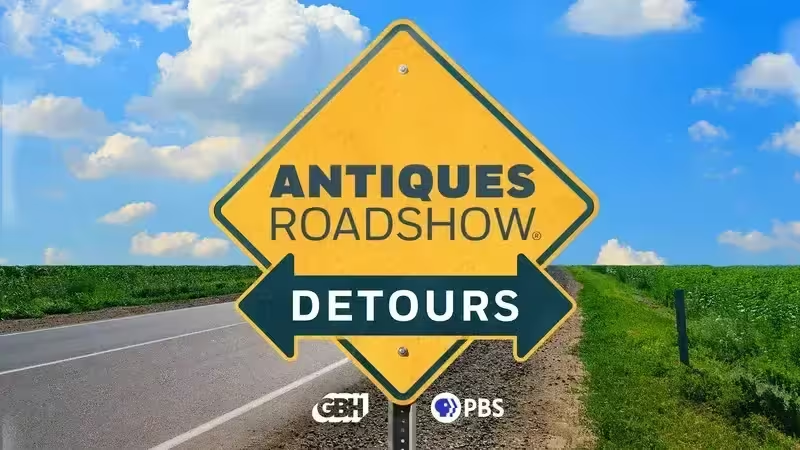
ANTIQUES ROADSHOW DETOURS
Ever wondered what happens to the treasures featured on America’s beloved ANTIQUES ROADSHOW after the cameras leave town? Host Adam Monahan tracks down the juicy afterlives of your favorite finds from PBS’s hit series.Providing Support for PBS.org
Learn Moreabout PBS online sponsorship♪ ♪ CORAL PEÑA: You won't believe what "Roadshow" is unearthing at Denver Botanic Gardens Chatfield Farms.
He's just awesome!
(laughing) I mean, literally, you almost gave me...
I'm still freaking out that I'm seeing this right now.
Cool!
So cool!
(laughs) ♪ ♪ PEÑA: Chatfield Farms, on 700 acres, is a true working farm in Littleton, Colorado, located along the banks of Deer Creek.
Here, the history of local agriculture is explored, along with a look to the future, studying and cultivating plants that do well in the area's climate.
The excitement about the treasures coming into "Roadshow" today is spreading.
Take a look.
This would have been, a wine cellar is what they call it originally.
GUEST: Cool.
This right here wouldn't have gone with it.
It, typically, it might have been wood.
I would think, you know, in today's auction market, it would be more desirable...
If you had the original liner, great.
As is, maybe $150 to $300.
Okay.
GUEST 2: See, I'm using it for exactly the same thing.
Oh, perfect.
Right.
We put wine in it.
Good.
GUEST: This is a poster from the 1968 Jazzfest in New Orleans.
I got it about ten years ago at an estate sale in Denver.
It was the estate of a jazz musician.
Do you remember how much you paid for it?
It was ten dollars.
The first Jazzfest was held in 1970, but this one is from 1968.
So what's going on here?
I think, I think it's real.
Is it?
I mean...
So, it is real.
For 1968 and 1969, there was a Jazzfest in the Municipal Auditorium with Sarah Vaughan, Dizzy Gillespie, Duke Ellington.
It was an amazing small event that two years later morphed into the jazz festival that we all know.
When you look for this image online, it doesn't exist anywhere.
Wow.
And I looked up Werlein's, and Werlein's is a now-defunct music shop in New Orleans.
Oh.
So that's where tickets were for sale.
Oh.
So this really is a rare document of the earliest days of Jazzfest in New Orleans.
My guess as to a value of this, and I can only be conservative, uh, would be between $800 and $1,200.
Wow!
But it really wouldn't surprise me if a Jazzfest nut-- and I, I say that endearingly, because collectors are crazy people, and that's why I'm in business... (chuckles) ...that if a real Jazzfest aficionado could pay several times that amount to acquire this at an auction.
Oh, my goodness.
(breathlessly): Wow.
I was not expecting that.
Thank you so much.
That's just... (laughs) That's wonderful.
GUEST 1: We got 'em about 50 years ago.
GUEST 2: A friend of ours was moving and downsizing, and we ended up with these lovely things, which I've never been fond of, but... (chuckling) They're different!
GUEST: I brought this Denver Art Museum poster.
It's actually the original, probably used to make the poster.
You can see, if you look closely, they have the original correction marks.
It's very Art Deco-- I would think probably 1940s, if I had to guess.
But I'm really curious to hear what they think about it.
GUEST: This was my grandmother's.
My mom received it when I was about 12.
And then I received it from my mom when I was about 35.
And I took it to a jeweler and tried to get it appraised, and I had noticed that it said "Marcus & Company" on the back.
Right.
And I thought back then it was part of Neiman Marcus.
Right.
And at the time, they said, "Well, we're not really quite sure."
So I've seen other items that were Marcus and Company on "Antiques Roadshow."
And it's just, like, this person has Marcus, and this person has Marcus.
I have a Marcus.
Yes, you do.
(laughs) Well, let me tell you a little about Marcus and Company.
It was a father and son that started it, and they had a place in Manhattan.
One of the prominent jewelers of the time.
It is carved emeralds in the Tutti Frutti style, which was very hot in the '20s and '30s.
Oh.
It's Art Deco era.
Oh, okay.
And it's done in platinum, and it's got brilliant-cut diamonds, and it's very desirable.
They still make Tutti Frutti-style carvings to this day.
Oh, really?
But the original artifact, which you have here, from the Art Deco era, is awesome.
It's beautiful, and it's in really good shape, because emeralds are p, pretty soft.
Yeah.
They're not like diamonds or sapphires or rubies that are much harder and survive better.
So, to have this carving that is still in such great shape is amazing.
When you had it appraised, they didn't tell you the value or anything?
My mom has the appraisal somewhere in their house that they've lived in... Sure.
...since 1976.
(laughing): So, I don't have the appraisal, and I keep it in my safe, and I bring it out for, like, birthdays and Christmas.
I don't have it insured, either.
I know that's kind of naughty.
I was guessing somewhere between maybe $5,000 to $10,000?
Did somebody ever offer to buy this from you?
Long time ago, probably in the late '80s.
My mom considered selling it, and there's some other pieces that are not Marcus, but some other pieces go along with it.
And they offered her about $3,000 for the entire set.
And I was, like, "Don't you dare."
You are correct.
"Don't you dare."
That would've-- I mean, it's good you held onto it.
I believe now, that if you were to have this in a nice high-end retail jewelry store, it'd be around $25,000.
(softly): Fantastic.
Yeah.
Thank you so much.
That's fantastic news.
I love it.
I love to see that big smile.
(laughing): I just love it.
This belonged to my grandma and grandpa, and about five years ago, it came into my possession.
I thought it was really pretty, so I grabbed it.
It's a French clock, made circa 1890, and we call it a brass and glass clock or a crystal regulator.
There's a maker's mark on the backplate of the movement, Marti's.
And what's unusual about this clock is, it's oval-shaped.
This is a really neat shape.
You don't see this very often.
You would buy this clock in a retail situation for around $1,200, $1,250, yeah.
(exclaiming) Dang.
(both laugh) It's better than most.
Okay, we'll find...
It's better than most.
We'll find a better shelf for it in the house.
Yeah.
Yeah.
GUEST 2: We'll find an oval shelf.
(all laugh) Yeah.
GUEST: I actually inherited them almost 20 years ago.
It was on my mother's side.
They got to my mother from her Uncle Robert, and then before Robert, it was with George.
So, from what I understand, these spoons were part of a s, like, story time.
So, for instance, Uncle Bob would, you know, sit all the kids down, and he would display the spoons.
He said that they were Revere spoons, as in Paul Revere.
And how did he know that?
Because he had inherited them from his father.
So as you know, these are marked with the name Revere.
This is a set of six spoons that is also engraved with the letters "A.A." at the downturned tip.
That "A.A." may relate to a family in Boston, Anna Amory.
And I don't know if there's any relationship between an Amory family and your family, but Paul Revere's record books show a great deal of silver made for Anna Amory and Anna Amory's family in 1796, much of which was marked with this same "A.A." intersecting at the bottom.
We'll date these right around 1796, because of the possible connection to the Anna Amory service.
So besides being a patriot and a Son of Liberty, Paul Revere also came from a silversmithing family.
His father, Paul Revere, Sr., was a silversmith in his own right, and I believe died just before Paul could legally take over the business.
So he had to apprentice for a little while.
Then of course, there was an American Revolution in the middle there.
Paul Revere, Jr.-- this being Paul Revere, Jr.'s work-- has certainly emerged as the more desirable of the Revere silversmiths.
What I'd really love to be able to do with these is to dig into that history.
His account books are fascinating.
They list somewhere around 5,000 silver objects that he made.
He was one of Boston's most accomplished silversmiths in the late 18th and early 19th centuries.
Spoons like these don't come up very often.
They're an unusual size, about seven-and-a-quarter inches, which is sort of in between a tablespoon and a teaspoon.
Mm-hmm.
So we'd call these a small tablespoon, rarer than teaspoons and rarer than tablespoons, but tablespoons still are the most desirable.
Were these to come up in an auction of like property and well-publicized, we'd expect them to carry an auction estimate of $20,000 to $30,000.
Wow.
Really?
If you were to want to have these insured, you'd probably be looking at a value closer to about $50,000 for the set of six.
Wow, that's amazing.
(laughing): That is-- that's amazing.
GUEST: This is a postcard of my husband, Harry's, grandfather, whose name was Harry.
He was named after him, and he's right here, along with two of his brothers.
They were farmers.
They played on the Grange, uh, baseball team.
My Harry bought his grandfather's house in Littleton, and then discovered these in one of the trunks.
So you're representing Littleton with the postcard.
That's right, that's right.
I appreciate that.
What really excites me-- and no offense to Littleton-- is the six, your complete set of 1911 M110s "Sporting Life" cabinet cards.
"Sporting Life," in its infinite wisdom and to compete with the publications at the time, thought, "Let's use the likeness of ballplayers and sell our publication."
So, on the back of these, uh, cabinet cards, you see exactly that, an invitation to read "Sporting Life."
In promoting itself, "Sporting Life" smartly used the images of the players, but they were not promoting baseball teams.
So when you look at the jerseys, they're nondescript.
These are about as rare a cards as you'll find.
Wow.
And we've got Ty Cobb, Frank Chance, Larry Lajoie, Christy Mathewson, Hal Chase, and Honus Wagner.
On the front, we've got pastel-colored lithographic depictions of each player.
We looked at 'em closely, and we consider the edges, uh, the corners, potential creasing, and things that astute card-graders look at.
And we think that, based on all of that, a condition a, assessment of low- to mid-grade would be warranted for these cards.
Okay.
The cards are not made of thick card stock like cabinets were at the time, which makes them more condition-sensitive.
If you were to insure this, you could insure for up to $100,000.
Whew!
Really?
Absolutely.
(laughing): Okay.
Never thought that, okay.
(chuckling): Yeah.
And, and you probably should.
(laughs) And we should, okay.
(both laughing) All right.
Yeah, these are some, some pretty scarce cards.
These are about as rare as they come.
Okay.
Yeah.
Whew!
It's great, I love it.
(both laugh) My husband'll be very surprised.
(both laugh) Wow.
PEÑA: The Denver Botanic Gardens opened Chatfield Farms to the public in 1989.
But it was a massive flood in June of 1965 that led to its establishment.
There was a huge rainfall event south of Denver, up, actually on a tributary of the South Platte River, and it came down and flooded most of the, uh, South Platte Valley through Denver.
It was hugely destructive.
PEÑA: In the aftermath of the flood, 27 counties in Colorado were declared disaster areas by President Johnson.
The land that is now Chatfield Farms was condemned as part of a flood control project.
Denver Botanic Gardens has co-managed Chatfield Farms with the Army Corps of Engineers since 1973.
APPRAISER: You brought me a book today.
Yes, a William Morris book.
Yes!
I, I love William Morris.
What do you know about William Morris?
Um, he's a s, a socialist, uh, textile-- wallpaper, I believe.
A poet.
William Morris is beloved by book people because he wanted to embrace the book arts in a way that, in industrial England in the 1890s, some of the traditions of designing type, making paper by hand, designing books in a way... Yeah.
Yeah, more going back to the way books were designed in the 1400s.
Fun.
Because at that point, the Industrial Revolution had kind of taken a lot of the soul out of books.
Cool.
And I think if we look at this book, and this book is not only written by William Morris, but printed and type-designed by him...
Yes.
...and his press.
It's, was called the Kelmscott Press.
William Morris, in addition to being a designer, also did write.
Right.
And he wrote the text of this book, "Love is Enough," a morality play, written also emulating the style of the Renaissance and the medieval things that he loved and surrounded himself with.
The illustrator is Edward Burne-Jones, the pre-Raphaelite London painter and friend of William Morris.
And all of these woodcuts were made specifically for this book.
So how did you happen to come into possession of this?
I do household cleanouts.
And I was actually at the dump with, with a, uh, a few pieces of furniture.
And it was a desk.
And I was taking the drawers out of the desk and one by one throwing them away.
(laughs) And the, the middle drawer was stuck, and I couldn't get it.
And I just gave it, you know, a little old one-two.
(laughs) And when I pulled out, that book fell down.
Really?
And I pulled it out, and it had a letter in it from Sothersby, which alerted me that maybe this was something I should probably not toss into the waste, so... Yeah, and then did you open it and check it out?
I did, and it was, like, "Oh, my gosh, look how beautiful this book is."
And I actually immediately closed it, put it back up, and put it in my truck.
(laughs) Yeah, it's really special.
This was printed in 1897.
He wrote it earlier, but they had a lot of trouble balancing the type, deciding what kind of illustrations, and balancing the borders and everything.
So it was actually done just after his death.
The Kelmscott Press printed books between 1891 and 1898.
Wow.
This is one of only two books that they printed in three colors.
So there are some pages like these that are black with red.
And there are some that are black that have blue ink, as well.
Interesting.
Which is quite special.
People love William Morris's work and what he did, especially for the book arts.
Yeah.
So this was published in 300 copies.
This is printed on paper.
Some of them are printed on animal-skin parchment, which is the same as our binding material here, just thinner.
Got you.
Those are more valuable.
An auction estimate for this book would be $4,000 to $6,000.
Wow.
And on the retail market right now, there are some that are, the retail asking price is $10,000 for this.
Oh, my gosh.
That's incredible-- thank you so much.
You're welcome.
It is, it, and it's, it's very well-preserved.
It's a, it's wonderful, and I'm glad that, that, uh, it, it didn't go to the dump.
I'm glad it was stuck in that drawer for so long.
Yeah.
(laughs) It saved its life.
Totally.
GUEST: When my great-grandfather passed away in the '90s, he ran a boarding house.
My dad and his siblings went to his house and pillaged and went through all the stuff had, that had accumulated through the years.
(chuckling) They found w, uh, three Superman figures.
My dad took, got one, and then I'm not sure if my uncles got the other two.
This is a Superman figure.
Okay.
But there's a lot of Superman figures.
Yes.
This is the Superman figure.
Superman, the quick story is, created by Jerry Siegel and Joe Shuster.
He first appeared in 1938, "Action Comics" 1.
Cover date June of 1938.
Book went on sale April 1938.
Superman literally changed our world of comic book... Yeah.
It would not be the same.
Mm-hmm.
We would not be doing what we do with comic books if it weren't for Superman and "Action Comics" 1.
This is the birth of superheroes as we know them.
This would have been released in 1942, and this is not something you could buy.
Okay.
This would have been a retailer incentive to promote DC Comics.
Okay.
Do you know what he's made of?
Wood?
Happy you guessed wood, 'cause it's close.
(laughs) But it's actually known as SyrocoWood, which was invented in upstate New York in the late 19th century, in Syracuse.
And what they would do is, they would take a wood pulp and mush it into a mold, let it harden.
It was to create a faster track instead of actually carving wood.
Now, when it comes to this particular figure, there are two versions.
There's one, as we see here... Mm-hmm.
...in this unusual kind of brown and red pants fashion, which is not the Superman as we know him in his blue and red suit.
No.
And then there is a blue and red version.
Now, when we look at this figure compared to the fully painted example, we only have paint applications on his hair, face, chest, pants, and boots.
Condition-wise, I consider him rather remarkable.
I mean, he retains so much of his original paint.
There's no chips.
He's just awesome!
(laughs) I mean, literally, you almost gave me a...
I'm still freaking out that I'm seeing this right now.
(laughs): Okay.
So I apologize in advance.
In terms of DC Comic history, collecting Superman and DC novelties, it literally does not get better than this.
This is the start of it all.
It's one of the earliest figures of Superman.
Conservatively, at auction, to under-promise, over-deliver, I would say, for the brown and red Superman, it's easily a $3,000 to $5,000 figure.
Three to, okay.
(voice trembling): Mom and Dad are gonna be really happy.
That's awesome.
Yeah.
I have to tell the uncles, too.
(laughing) Especially if you got two more hiding in a closet!
(laughing): Yes.
And to put it into perspective, I'm being conservative.
Mm-hmm.
Because the last one that came up for public auction, which was in 2023... Mm-hmm.
...brought a little over $6,000.
And the condition of yours blows that one out of the water.
So this is gonna achieve a pretty penny if it were to ever sell publicly.
Okay.
Thank you, Travis.
This is why, why I exist!
(laughs) What I live to see!
I don't know much about it.
50 years ago, I traded a pair of cowboy boots for this from a friend.
But friends told me that this wor, might worth more money.
20 years ago, I babysat for my boss while him and his wife went to Bali, and they came back and brought me this vase.
I don't know anything about it, so that's why I'm here.
(chuckles) GUEST: I brought a photograph from William Henry Jackson.
It's of the Animas River and the Denver and Rio Grande coming from Durango to Silverton, Colorado.
I acquired it at a auction probably 15 to 20 years ago.
I'm kind of a train buff... Mm-hmm.
...of Colorado railroads.
Okay.
And I liked the train.
And then when I saw it was a William Henry Jackson, that just made it that much better.
This is a beautiful photograph.
It is, as you said, by William Henry Jackson.
The title is "Canon of the Rio Las Animas: The Needle Mountains."
It's a mammoth plate albumen print, so that refers to the size of the photograph.
A mammoth plate print was made from a glass negative in this exact size, which is pretty extraordinary.
William Henry Jackson is really known as a photographer who worked in Colorado, so local to where we are today.
He's actually w, uh, East-Coast- born, he's from New York state.
He served in the Civil War, and then he headed west.
He worked as a bullwhacker in Nebraska.
So he really had kind of this rugged, hands-on experience in what was then really the West.
He then opened a photo studio in Nebraska.
He was taking portraits, decided that wasn't really working well for him, moved to Colorado.
He was relatively quickly hired by Ferdinand Hayden, who was doing a geological survey of the Western territories and states.
And that was in 1870, and he was hired to document it as a photographer.
Hayden really recognized how important photography would be to his mission, which was to record the geology of the area.
He headed down the Yellowstone River, and those images were published relatively quickly and really caused a pretty major sensation, because people had never seen the elements of the Western landscape that we're all familiar with today, like the geysers and humongous waterfalls.
I mean, this was brand-new.
Just two years later, in 1872, that region became our first national park, Yellowstone National Park.
The photograph is circa 1882, after he had completed his work for the geological survey and had begun opening his own business in Denver.
At this point, Jackson was commissioned by a lot of railroad companies to document the railroads, which were expanding into this region.
When you think about it, he's lugging enormous glass plates, all of his chemicals, a tent to develop the plates, which needed to be done quickly.
So he was really working very hard to produce these stunning photographs.
Yeah.
How much did you pay for this?
I paid $250 for it.
Okay.
Do you have a sense of how much it might be worth today?
My guess would be $3,000-plus.
Okay.
I don't know, really know.
My estimate at auction would be $6,000 to $9,000 for this print.
Okay.
Yeah, thanks.
(chuckles): Yeah.
That's really neat.
GUEST: This is an English artist's riverscape painting.
My dad got it probably 20 years ago when he was in England.
I can't remember the name of the bridge, but I know it's a famous bridge somewhere.
Do you happen to know the, uh, the artist?
Um, it is J. Lewis.
Mm-hmm.
And I believe he's in the Royal Academy of Art.
GUEST: My mother-in-law gave it to me.
She was going to put it up for sale in a yard sale, and I grabbed it.
(laughs) It could possibly be a Picasso lithograph.
He made a lithograph of the same image.
But then this one is reversed, so the whites are black, blacks are whites.
I'm hoping that this is an original and I'm going to retire after this.
(laughs) GUEST: This piece belongs, uh, uh, my husband's side of the family, it belonged to his great-grandfather.
APPRAISER: Okay.
And I'm told that he used it to store his cigars.
He lived in the Midwest.
And it's been passed on ever since.
That's a fancy cigar box.
Yeah, it is a fancy cigar box.
Would it surprise you if I told you it wasn't made to be a cigar box?
You know, it really wouldn't surprise me.
(both laugh) It is a biscuit jar.
Oh, wow.
A biscuit box.
Interesting.
So, and it's a very fancy one at that.
Yeah.
You've got this griffin- dragon form on the front.
And then, as you rotate it, you've got these wonderful Gothic arches done in multiple colors.
And then, if you take the lid off, it actually has the marks "M.W.," for Mount Washington.
Wow.
So this is made by the Mount Washington Glass Company.
They were based in New Bedford, Massachusetts.
Wow.
And it probably dates to about 1894.
It is, um, from their Flemish line, which is their very top of the line.
Uh-huh.
This very European decoration.
Right, right.
With the griffin.
So this was really high quality.
Uh-huh.
It would have been silver plate, so this would have been very shiny.
Shiny.
It's worn off over the years.
Yeah.
But it's a lovely piece.
Have you ever have it, had it valued before?
I have not.
Okay, well, at auction, it would be $2,000 to $3,000.
Wow, that's great.
So... Yeah, that is great.
Good.
Um, they'll be thrilled.
Good.
I might have to use it as a biscuit jar.
(laughing): You might!
(laughing): In my kitchen, right.
Clean it real well first.
Right, well, yeah.
(both laugh) This is a Glenna Goodacre bronze statue.
I inherited it from my parents.
They collected a lot of art.
They traveled to New Mexico... Mm-hmm.
...and they, they picked this up in Santa Fe.
She's a really wonderful artist.
She was born in 1939 and she died in 2020.
So, she studied at the Art Students League.
She was a member of the National Sculpture Society, a very prestigious organization.
She did the Vietnam Women's Memorial in Washington, D.C., which is probably her most prominent piece.
And she did a wonderful sculpture about Irish immigrants that's in Pennsylvania, And it's 35 life-size sculptures.
So it's really incredible.
And then she did the dollar coin.
So she depicted Sacagawea, who was a Shoshone guide for the Lewis and Clark expedition.
Hm.
Most of her career she spent doing sculptures of Native Americans.
And I think here we have a wonderful depiction of a Native American child.
You had the original bill, and what was the title?
"The Orphan."
The piece was made in 1993, and it's very clearly signed here, Glenna Goodacre.
And it's number eight in an edition of 35.
And here it's dated 1993.
And interestingly enough, she signs it "G." She didn't want people to know that she was a woman artist.
Hm.
There was certainly prejudice against women sculptors.
Well, you can see this wonderful sort of loose technique here.
You get a feeling how the original was probably modeled in wax.
So you have this wonderful contrast between this very expressionistic kind of hair and a very smooth face.
You don't know what your par, parents paid for it.
I think they paid a couple thousand dollars.
In a retail setting, a, a replacement value, it's probably worth about $7,500.
Oh, wow, great.
Mm-hmm.
(honking) PEÑA: Walking the several miles of trails here, you'll pass various Colorado ecosystems.
You can trek through the woods, along Deer Creek, and over to the agriculture area and farmstead, where several lucky rescue animals now have a safe home.
GUEST: This is a watercolor that my father had for my entire life.
I grew up with it, and it was always one of my favorites.
I, I always loved the whimsical, uh, frame.
I knew my father was a huge fan of George Herriman's cartoon strip "Krazy Cat."
This is Officer Pupp.
Both my parents were junk collectors, and my mother found this in a thrift store, paid maybe 50 cents or a dollar for it, and then surprised my father with it.
And he was just delighted.
So it w, hung in a special place in the house.
I know that it was created in 1933.
I believe George Herriman, the cartoonist, was a member of a gentlemen's club, and they had put on a "spoof" art show.
And I believe George Herriman had a, awarded himself first prize.
(laughs) So there's a little note there.
It's really faded.
A little bit about Herriman first.
He was born in 1880 and his parents were a mixed-race couple, Creole, and he never really embraced his heritage.
Always tried to hide his heritage.
When he was ten years old, they moved out to Los Angeles, where he looked for work.
He dabbled in a whole bunch of different cartoons, and then hit on "Krazy Kat," which ran from 1913 to 1944.
He had gotten a contract with King Features, who were the ones who had the rights to "Krazy Kat."
On the slip, it says, "Uplifters Inanimate Dog Show," dated May 14, 1933.
And Herriman typed in his name there, "first prize."
So he awarded himself the first prize.
What you have in any kind of appraisal on a good cartoon strip, you have to look at a lot of factors.
Characters are real important.
"Krazy Kat" was a pretty simple strip.
It had three characters.
You had Krazy Cat, Ignatz Mouse, and you had Officer Pupp.
Ignatz's goal in life was to hit Krazy Cat with a brick.
Krazy Cat thought that was a sign of affection, and wanted to get hit with a brick.
And Officer Pupp was there to stop the whole thing from going on.
What Herriman did do, he traveled quite a bit and he wound up going on trips.
He would go quite often to Arizona.
Right here, "Coconino County."
And that you can tell in the influence of the artwork, with the colors, with the kind of beiges and the reds and, you know, the desert scenes.
This is a great example of a watercolor that Herriman did.
He hand-colored some of his strips.
But his specialty pieces were almost always watercolor, like this.
Doesn't have Krazy Cat, it doesn't have Ignatz, which would have been a very, very big plus.
But you do have Officer Pupp, and it's a really great image of him.
The condition on the artwork itself is terrific.
And to me, one of the real big pluses is, this is an original Herriman frame.
And in all the years of doing this, and I've handled a lot of Herriman stuff, I think I've seen a frame, original one that he did, with one piece.
They're not very easy to find, and it adds quite a bit of value to it.
It's just a great specialty piece.
And the fact that it's fresh to the market, it's never been seen in... How many years since your folks got it?
My, uh, parents have had it since the 1950s.
At auction, I would easily estimate this between $25,000 and $35,000.
(inhales): Wow.
Yeah.
Yeah, it's a great piece.
Had Krazy and Ignatz been in it, you could have jumped that up quite a bit.
A couple years ago, I was looking around at trains and stuff that was for sale.
This caught my eye.
It was big, bigger than most.
The guy was asking $200.
It is modeled after a real steam engine.
This is a 700E Hudson engine made by the Lionel Corporation.
It's a 4-6-4 truck configuration.
It's very heavy.
I agree, oh, yeah.
Much heav...
Very heavy.
Much heavier than most trains.
This engine, uh, and tender, they're made of a die-cast mold as opposed to being a tinplate train.
This was Lionel's introduction into scale-model railroad, instead of just toy trains.
It's actually a 1:48 scale of the original Hudson engine.
It's a very exact scale model.
Lionel invested a lot of money to create this.
This train could be electrified and ran on train tracks, or it could be prominently displayed as a presentation piece.
They originally produced this in 1937, and it ran for five years, until 1942, when they had to stop it for World War II.
Then they did reintroduce it again a few years later with some slight modifications to the design.
And this is a pre-war example.
That's when they were stamped the 5344.
This was really expensive at the time it was made.
This would have cost anywhere from $50 to $75.
It was a very popular seller.
The president of Lionel himself even had this on his mantel.
Given this heavy weight of several pounds and how brittle die-cast can become, this can break very easily.
The front end, for example, the cowcatcher, this could easily crack, be dislodged, broken off entirely.
The other thing that happens on these engines is, they can warp and bend.
I'm very happy to report yours is in beautiful condition.
It is authentic and it is all original.
In this condition, this train engine and tender would have an auction estimate of $2,000 to $3,000.
Really?
Wow.
I wouldn't have expected that much.
No, not at all.
That's really cool, though.
Thank you so much... My pleasure.
...for all the information.
I remember seeing it as a child in my grandmother's home, and I always had my eye on this.
Well, the first thing I noticed on this is how beautifully it's hand-chased.
It's sterling and it's Gorham.
It's probably late 1800s?
And what have you had done to this?
It was always very shiny as a child growing up.
So my grandmother kept it in good shape.
My mother continued to polish it, and then she had it lacquered.
Well, that's an interesting way to get something so you don't have to polish it.
Exactly.
(both laugh) Most people that collect vintage silver would like to see part of the old patina.
You might see a 30% or so reduction in the value of a piece that's been highly polished.
Replacement value on this would be at least $5,000.
Oh, my goodness.
Grandmother, be happy.
(both laugh) It will continue to go to my granddaughter, who's already eyeing it at the dining room table.
Those attractions to sh, shiny things... Yeah.
...go through the family genetics, I think.
So, I think, I think so!
(both laugh) We all like it.
I brought in a, uh, Navy sword, a dress sword, and belonged to Commodore Morris, who was a distant relative of mine.
APPRAISER: He's got a very interesting history.
He went to sea at the age of 15 in 1799.
Mm-hmm.
And is immediately made a midshipman.
He served during the Barbary Wars, he served during the War of 1812, and most importantly, during the War of 1812, that battle between the Constitution and the Guerriere, he was the first lieutenant under Captain Isaac Hull, who was the ship's commander at that time.
Dealing with the Barbary pirates, that was one of the very first times the American Navy had an opportunity to sort of flex its muscle and prove that we were a power to be reckoned with on the sea.
Mm-hmm.
When he passed away in 1856, he had 57 years of service in the U.S. Navy... Wow.
...and was the second-highest ranking still-serving U.S.
Naval officer at that point in time.
Huh, wow.
And this sword is a U.S. model 1852 Naval officer sword.
In fact, this is the pattern that is still in use with the U.S. Navy to this day.
This is one of the very first U.S. model 1852 Naval officer swords.
Oh.
You've got a wonderful etched Ames Manufacturing Company mark on the ricasso that tells you who made the sword.
And then stamped at the base of the ricasso, you have the date 1852.
Only 500 swords were in that initial order.
The sword is decorated with the typical naval motifs.
You've got the sea serpent on the quillon... Mm-hmm.
...the USN and a ribbon on the face of the guard.
You've got the knots on the, uh, mounts, and you also have the sea serpent on the drag.
I love him.
And on the reverse of the blade, we've got the etched USN and a ribbon, and we've got the fouled anchor motif that is so associated with naval arms.
Now, the sword is in pretty darn good condition.
We have some of the gilt still on the brass hilt.
We've got a lot of the polish and frosty etching on the blade.
There is some surface oxidation and a little bit of light surface rust.
Because it is a first-contract Ames model 1852 Naval officer sword, very scarce sword, if it had absolutely no historic association, it would be worth at least $2,000 to $3,000 at an auction setting.
Mm-hmm.
But you have this amazing family history for a very iconic U.S.
Naval officer.
If this sword were to be offered in a retail setting, we think the asking price for the sword would be in the neighborhood of $25,000.
Wow, that's amazing.
We would probably insure it in the neighborhood of $50,000.
Wow.
Because it is absolutely irreplaceable.
You could go find another first-contract 1852 Naval officer sword, but you couldn't find Commodore Morris's sword.
(chuckles): Gosh, that's really wonderful information.
I bought them at a thrift store for two dollars.
I know they're some sort of riding boots.
I figured I would bring 'em since I can't find anything about 'em.
It's a beer stein, it's actually started, uh, me collecting beer steins.
I bought it about, uh, ten years ago at an antique shore, store back in Michigan.
I thought it was pretty unique.
Turns out it's about fif, worth about $60, and it's from, like, the '20s.
So I was off by about 100 years on how old it was.
But still really cool to, uh, to learn more about it.
GUEST: I was given this doll by my parents.
They used to go to Europe and bring back foreign dolls.
And I was probably about eight or nine years old.
And where did they purchase her in Europe, do you know?
In Germany.
What's her name?
Her name is Lilli.
Now, when you played with her, did your friends have Bild Lillis, too?
No, they all had Barbies with dark hair and bathing suits.
And my Barbie had a black-and-white dress, and I couldn't take off the shoes and I couldn't change her earrings, and... (sighs): I was kinda disappointed in her, 'cause I wanted a real Barbie, but my parents wouldn't buy one.
So what we have here today is a Bild Lilli made in Germany.
Bild Lilli was a doll made in the 1950s through 1964 by a company called Greiner and Hausser.
And she is actually fashioned after a cartoon character for the "Bild-Zeitung" magazine.
And it was sort of a gossip magazine.
Reinhard Beuthien did the cartoon, and she was, um, she used her good looks to her best advantage.
But she was fun and sassy and she was very fashionable.
She was sold to gentlemen, like, in smoke shops and so forth.
And they would put 'em on the dashboard of their car, or in the cockpit of their airplane.
She's all pretty and curvy.
I don't think my parents knew that.
They didn't, because what happened... (laughs) ...German children, and even German women, started wanting this doll because she was pretty.
In the late '50s, Ruth Handler, who is of Mattel, one of the founders of Mattel, she was in Lucerne, Switzerland, with her daughter Barbara, and they see this doll in the shop window and they buy it.
You can see Barbie was fashioned a lot like her.
There actually ended up being a lawsuit between the makers of the Bild Lilli and Mattel... Uh-huh.
...for pretty obvious reasons.
They settled out of court.
And then in 1964, Mattel bought the rights to the doll.
Did she have other clothes?
Nope, this was the only outfit she had.
She has on this beautiful dress that you were wishing was a black-and-white-striped bathing suit, and you got a black-and-white cocktail dress.
But how do we know it's original to her?
One thing we can do is look at her snaps, and you will see that it has P-R-Y-M. All the original clothes will have that brand of snap on them.
And not only is it her dress, it is a rare dress to find.
I've been doing this show for 13 or 14 years.
Uh-huh, uh-huh.
And I have never seen a Bild Lilli.
(inhales) Super!
She came in two sizes.
There was a seven-inch model and a 12-inch model.
Oh.
Oh, okay!
And guess which one everybody wants if they collect Bild Lillis?
Do they want this one?
They want the bigger one.
Ooh!
Cool!
So cool!
(laughs) So the retail value on your doll in today's market, because of the rare dress, she would retail somewhere between $3,800 and $4,500.
Mm.
Hm, I guess I'll take her rather than a Barbie.
(both laugh) Yes.
Insurance value?
Insurance value, I would probably put around $5,000 to $5,200.
An early Barbie from the same period is going to probably sell for about double what a Bild Lilli will.
GUEST: It came from an estate sale in Boulder in the '80s.
It was somewhere between $60 and $90 at the absolute most.
I just find it fascinating, all the little joints.
The figure is articulated, so it's made of very small metal components that have been put together that required enormous skill.
Look at how flexible this is.
All the different elements move-- each of those little joints.
And in this case, the metal is copper.
When you open it up, we're rewarded with the signature of the maker.
I've ever noticed that.
Right there on the breastplate.
Yeah.
Who's not somebody who's well-known.
His name is Masa-Aki.
This is Japanese, and Masa-Aki, I'm confident, was Japanese.
And I'm also sure that he was one of the people who was displaced during a huge industrial change in the culture of Japan during the late 19th century.
The people that were not needed for their skill sets in that parti-, in their original training were those who were armorers, those who were engaged in making the armor for the samurai.
And some of them became very famous at making other kinds of things, such as models of naturalistic forms.
Okay.
And the names are, we know.
Others were not known.
And this is one of the people who is not known.
It would have been sold to someone who was likely outside of Japan, primarily in the U.S. or Europe.
So it dates to around 1900.
I think that, reasonably, one could expect to get $2,500 to $3,500 for this.
Okay.
At auction.
Uh-huh.
Thank you very much.
PEÑA: What's growing at Chatfield Farms in the spring?
This is our market garden area, where we grow smaller amounts of leafy greens.
We have everything behind me, from lettuces to bok choy to carrots.
PEÑA: But the work never stops, even when there are no crops in the field.
HART: The greenhouse is extremely important in the winter months, because we do all of our plant propagation there.
All of the vegetable crops and flowers and ornamental plants that we have around Chatfield are started up in the propagation greenhouses.
GUEST: My family acquired this through my great-aunts and -uncle that lived in Norwalk.
And when Tiffany factory shut down, what we have heard is that they bought two barrels of Tiffany.
So there's a large collection.
This is just part of it.
And we have divided it among our family, my sisters and myself.
And I have brought in four pieces that I really love.
It is all Tiffany glass.
These I would absolutely date from about 1928, this piece, this piece, and this piece.
And this one is actually much earlier.
Uh, it was made between 1900 and 1903.
And this is a very unusual piece, 'cause it's what we call a paperweight glass vase.
Mm-hmm.
Paperweight because of the heaviness, but also because it's transparent.
I've seen one other like it in a different form.
That one is actually from the 1920s.
This one, it says a V prefix, so it's V with an, a number following it.
And the V prefixes, they only made 999 of them.
Mm-hmm.
And I have always believed that these may have been prototypes kind of pieces, because they're always a little more unusual and you don't see the same thing coming and going.
So I think this is an, a, a unique piece.
The decoration on this is fabulous, too, because you have these trailings, these vines, or stems, in purple-- not brown and not green.
Mm-hmm.
And then these beautiful little white flowers with little yellow centers.
And then these lovely leaves.
It almost looks like they're floating in water.
Now, the other pieces, from the 1920s, or, the, uh, certainly, this plate here and the bowl is what you would see Tiffany making in the 1920s, which was the pastel glass.
Mm-hmm.
But what makes yours more interesting is that it's a combination of techniques.
Yes, it is pastel glass, but it's actually paperweight pastel.
Oh!
And it has these wonderful pink morning glories in them.
Mm-hmm.
And on top of that, we also have these pulled areas of glass, so you have these little knobs.
Mm-hmm.
And that's really unusual, the, the combination of techniques.
So it's not your typical type of pastel glass.
It's, it's, they pulled out a, all the stops in making these.
Huh.
(murmurs) And this one, which is a flower-form vase, this particular form is called a calyx, because of, it's got the elongated cup... Mm-hmm.
...and it has the three flattened sides.
What makes this really appealing is that it's really a miniature.
Do you have any idea what your family might have paid for those barrels of glass?
I have no idea.
And they were schoolteachers, so I doubt that there was a lot sunk into it.
I would say that this particular piece would, I would put a value of $4,000 to $5,000 on it.
Mm-hmm.
This piece, I would say $5,000 to $7,000.
Mm, nice.
This piece, $6,000 to $8,000.
Mm.
And this piece, $25,000 to $30,000.
Wonderful.
So the total for the group ranges from $40,000 to $50,000 retail.
That's lovely.
They're beautiful.
My mother gave it to me, uh, in the early '80s.
It's an old, uh, Tonka fire truck.
A little research s, says maybe 1950s, I, I think.
It's got a lot of sentimental value.
It was my brother's flute.
He passed away at, right at the beginning of COVID.
And he's had it since, like, I can remember, since, like, '76, and kind of played, taught himself how to play.
And he was no Jethro Tull or Ian Anderson... (chuckles): ...or anything, but he was pretty darn good.
GUEST: It is a piece of art that I inherited from my stepmother who lived in Washington, D.C., in the 1970s.
She was a lawyer with the federal government.
She loved art, and so she educated herself.
She went to galleries, museums, and whenever she and my dad had a little extra money, they would buy a piece of art and bring it into their home.
She s, paid $800 for it.
$800, wow.
Which was significant.
Mostly, they collected lithographs and... Yeah, it's a painting by an artist named Sam Gilliam.
Sam Gilliam was an African American artist who spent his entire ad, adult life and art career in Washington, D.C.
He was born in 1933.
He was originally from, uh, Mississippi, but grew up in Louisville, Kentucky, and went to college there, and then moved to Washington.
He was originally associated with a group of painters called the Washington Color School.
They were abstract painters.
They exhibited together in Washington beginning in the 1960s.
He had some early success.
He had shows at the Phillips Collection in Washington, D.C., in the late '60s.
He had a one-person show at MoMA in New York.
And then he was the first African American artist to show at the Venice Biennale in 1972.
His great innovation was, he did these large canvases which were stained, and they were sort of twisted and folded.
He didn't frame them, and he would drape them... Mmm.
...and kind of hang them in different configurations.
That was a real innovation as a way to look at a painting.
In, in the late '60s, he started doing that.
So your painting, it's beautiful.
It was done in 1974, and then it says "June 5."
Mm-hmm.
So that's either when it was done or maybe June 5 was the inspiration for the painting.
And it's painted on, uh, polypropylene, which is the same material that they make sails from.
And Gilliam liked it because of the way the paint's absorbed.
You have the lighter areas, where it's very thinly applied.
It's acrylic paint.
And then you have these heavier areas, where it's kind of laid up on top of the paint and you can really see the texture.
It's just a great example of that type of work that he was doing at that time.
You can even see here, where it looks like it, where it may have been folded, which is what he would do.
He would fold the pieces and crease them and just try to get the same feeling on a flat work that you might get with one of his draped pieces.
Sam Gilliam had early fame, and then he sort of struggled to get a lot of market attention throughout his life.
And then, ten or 15 years ago, he began to get a lot of attention.
Hm.
And so his market has really climbed in the last few years.
Mm-hmm.
Um, he passed away in, in 2022.
Mm-hmm.
These early works are very desirable.
In a retail situation, it would be priced at between $125,000 and $150,000.
(gasps) (whispers): No!
Oh, my goodness.
(laughs) I'm shocked.
(inhales) I'm shocked, yeah.
Yeah.
It's a, it's a really wonderful piece and a great, great legacy for your family.
Yeah, yeah.
Yeah.
Well, we hope to sa, we hope to keep it in the family for many years.
But that's, that's amazing.
I would insure it for $150,000.
Yeah.
Wow.
(laughs) PEÑA: And now it's time for the Roadshow Feedback Booth.
I broke my, uh, candle waiting in line, and then, uh, looked at the bottom for the first time and found this, uh, "Made in China" sticker.
(laughs) And then we brought, uh, this big steamer trunk, nice and heavy.
And when we got up to our appraiser, uh, we couldn't get it open, so it was locked.
(laughs) But we're doing this for our friends we made in line.
Yep.
(both laugh) What are their names?
Chris and Kathy.
Chris and Kathy, thanks for talking to us in line.
Thank... (both laugh) What have we here?
Oh, it's a flask.
You can keep it well hidden.
No one will know where it is.
And it's in the shape of a ham.
So when somebody asks you, "What's that in your sh, shirt?
", you just say, "Ham."
(both laugh) I brought my grandmother's jewelry all the way from Costa Rica!
And they are the crown jewels of our family, uh, but they're only a treasure to me.
William Shakespeare-- Willie Shakes here-- our early 1900s wildflower guide were only worth about $75 combined.
But meeting Nicholas Lowry and blowing a kiss to Kevin Zavian were not only two of the best moments of my life, but were absolutely priceless.
PEÑA: Thanks for watching.
See you next time on "Antiques Roadshow."
Owner Interview: 1942 DC Comics Promotional Superman Figure
Video has Closed Captions
Clip: S29 Ep11 | 1m 32s | Owner Interview: 1942 DC Comics Promotional Superman Figure (1m 32s)
Appraisal: 1852 Commodore Morris's Naval Officer Sword
Video has Closed Captions
Clip: S29 Ep11 | 3m 8s | Appraisal: 1852 Commodore Morris's Naval Officer Sword (3m 8s)
Appraisal: 1897 William Morris "Love is Enough" Book
Video has Closed Captions
Clip: S29 Ep11 | 3m 23s | Appraisal: 1897 William Morris "Love is Enough" Book (3m 23s)
Appraisal: 1911 Sporting Life Cabinets M110 Baseball Cards
Video has Closed Captions
Clip: S29 Ep11 | 2m 14s | Appraisal: 1911 Sporting Life Cabinets M110 Baseball Cards (2m 14s)
Appraisal: 1933 George Herriman "Krazy Kat" Framed Watercolor
Video has Closed Captions
Clip: S29 Ep11 | 3m 13s | Appraisal: 1933 George Herriman "Krazy Kat" Framed Watercolor (3m 13s)
Appraisal: 1942 DC Comics Promotional Superman Figure
Video has Closed Captions
Clip: S29 Ep11 | 3m 12s | Appraisal: 1942 DC Comics Promotional Superman Figure (3m 12s)
Appraisal: 1968 New Orleans' 1st International Jazz Festival Poster
Video has Closed Captions
Clip: S29 Ep11 | 1m 40s | Appraisal: 1968 New Orleans' 1st International Jazz Festival Poster (1m 40s)
Appraisal: 1974 Sam Gilliam "June 5" Acrylic Painting
Video has Closed Captions
Clip: S29 Ep11 | 3m 23s | Appraisal: 1974 Sam Gilliam "June 5" Acrylic Painting (3m 23s)
Appraisal: 1993 Glenna Goodacre "The Orphan" Bronze Bust
Video has Closed Captions
Clip: S29 Ep11 | 2m 2s | Appraisal: 1993 Glenna Goodacre "The Orphan" Bronze Bust (2m 2s)
Appraisal: Bild Lilli Doll, ca. 1955
Video has Closed Captions
Clip: S29 Ep11 | 3m 51s | Appraisal: Bild Lilli Doll, ca. 1955 (3m 51s)
Appraisal: Early 20th C. Tiffany Glass Collection
Video has Closed Captions
Clip: S29 Ep11 | 3m 37s | Appraisal: Early 20th C. Tiffany Glass Collection (3m 37s)
Appraisal: Gorham Sterling Silver Pitcher, ca. 1900
Video has Closed Captions
Clip: S29 Ep11 | 1m 11s | Appraisal: Gorham Sterling Silver Pitcher, ca. 1900 (1m 11s)
Appraisal: Japanese Copper Spiny Lobster, ca. 1900
Video has Closed Captions
Clip: S29 Ep11 | 1m 54s | Appraisal: Japanese Copper Spiny Lobster, ca. 1900 (1m 54s)
Appraisal: Lionel 700E Hudson Scale Train Model, ca. 1940
Video has Closed Captions
Clip: S29 Ep11 | 2m 3s | Appraisal: Lionel 700E Hudson Scale Train Model, ca. 1940 (2m 3s)
Appraisal: Marcus & Co. Art Deco Tutti Frutti Bracelet, ca. 1930
Video has Closed Captions
Clip: S29 Ep11 | 2m 48s | Appraisal: Marcus & Co. Art Deco Tutti Frutti Bracelet, ca. 1930 (2m 48s)
Appraisal: Mt. Washington Royal Flemish Glass Biscuit Jar, ca. 1894
Video has Closed Captions
Clip: S29 Ep11 | 1m 46s | Appraisal: Mt. Washington Royal Flemish Glass Biscuit Jar, ca. 1894 (1m 46s)
Appraisal: Paul Revere Jr. Silver Tablespoons, ca. 1796
Video has Closed Captions
Clip: S29 Ep11 | 2m 40s | Appraisal: Paul Revere Jr. Silver Tablespoons, ca. 1796 (2m 40s)
Appraisal: William Henry Jackson Photo, ca. 1882
Video has Closed Captions
Clip: S29 Ep11 | 3m 5s | Appraisal: William Henry Jackson Photo, ca. 1882 (3m 5s)
Appraisal: WWI 2nd Division 5th Marines Album
Video has Closed Captions
Clip: S29 Ep11 | 1m 3s | Appraisal: WWI 2nd Division 5th Marines Album (1m 3s)
Preview: Denver Botanic Gardens Chatfield Farms, Hour 2
Video has Closed Captions
Preview: S29 Ep11 | 30s | Preview: Denver Botanic Gardens Chatfield Farms, Hour 2 (30s)
Providing Support for PBS.org
Learn Moreabout PBS online sponsorship
- Home and How To

Hit the road in a classic car for a tour through Great Britain with two antiques experts.













Support for PBS provided by:
Funding for ANTIQUES ROADSHOW is provided by Ancestry and American Cruise Lines. Additional funding is provided by public television viewers.


